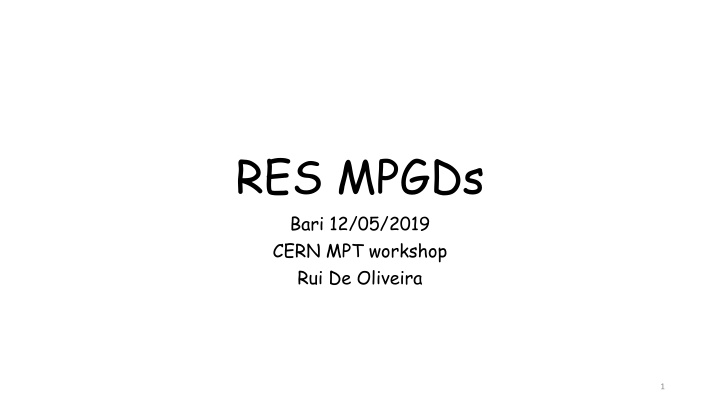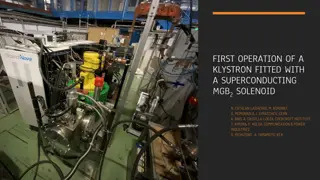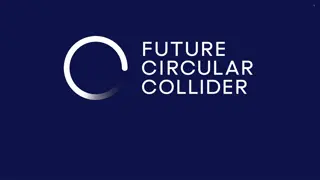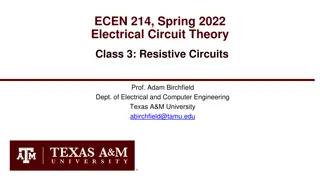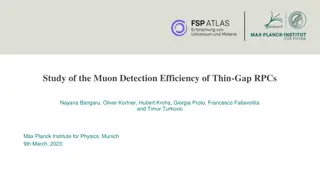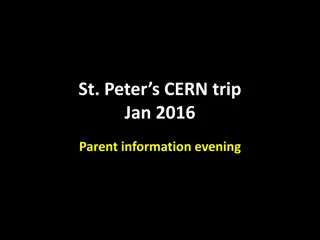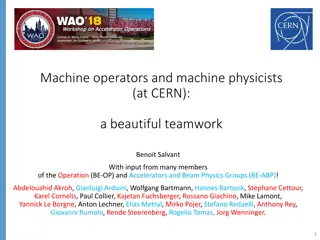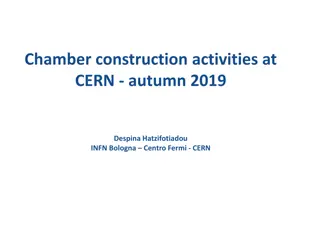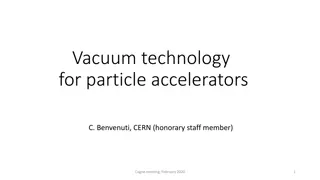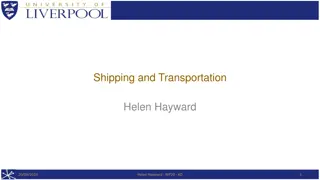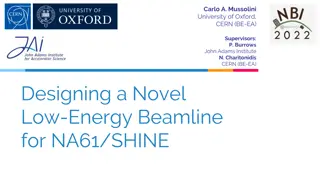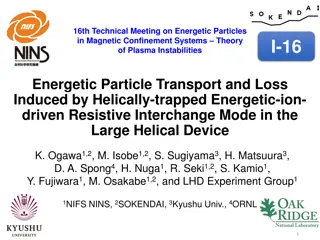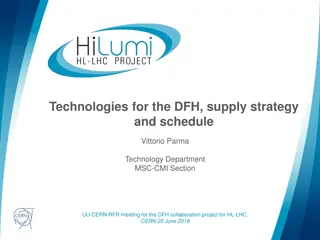Innovative Resistive Layers and Structures for Particle Detection at CERN
Explore the latest advancements in resistive layers and structures designed for particle detection at CERN. The research covers various types of resistive structures, including GEM and BULK Micromegas, and delves into topics such as spark protection, energy levels, and material vaporization. Detailed analysis of materials like DLC-coated Polyimide and uRwell structures provides valuable insights into optimizing performance and durability for particle detectors.
Download Presentation

Please find below an Image/Link to download the presentation.
The content on the website is provided AS IS for your information and personal use only. It may not be sold, licensed, or shared on other websites without obtaining consent from the author.If you encounter any issues during the download, it is possible that the publisher has removed the file from their server.
You are allowed to download the files provided on this website for personal or commercial use, subject to the condition that they are used lawfully. All files are the property of their respective owners.
The content on the website is provided AS IS for your information and personal use only. It may not be sold, licensed, or shared on other websites without obtaining consent from the author.
E N D
Presentation Transcript
RES MPGDs Bari 12/05/2019 CERN MPT workshop Rui De Oliveira 1
Existing Resistive MPGD structures GEM Family GEM Resistive GEM (single or double sided) Micro Wells Micro resistive Wells Single resistive layer Double resistive layer Micromegas Family BULK Resistive BULK Micromegas Single resistive layer Double resistive layer Micro BULK Micro resistive BULK Floating mesh Resistive Floating mesh Single resistive layer Double resistive layer THGEM Family THGEM Resistive THGEM ML THGEM MM THGEM THwell Resistive THwell 2
Resistive layers Spark protection Spark energy CV2 600 uJ in a GEM (10x10) , 30uJ in a classical MM , 10 nJ uRwell Below 10M we have observed damages, we start to have enough energy to vaporize materials ( no existing study on energy versus material vaporization) Charge sharing Rate capability is affected Depends a lot on the currents evacuation structure (single , double layers , exotics) Resistive layers tested at CERN Polymer paste 10Kohms to 100K/Square RuO Thick film paste 10K to 100M/square limitations Resistive Kapton Dissipative films 1G/square and above DLC 100K to 1T/square too low values nice but too many only a few values available too high values perfect range and possibilities 3
2016 DLC coated Polyimide DLC/Polyimide DLC 0.1 to 1um 100K to 1G/square Polyimide 50 um APICAL NP Kapton HN DLC/Polyimide/Cu Copper 0.2 Vac + 5um Cr 10nm Polyimide 50 um APICAL NP DLC 0.1 to 1um 4
uRwell structure Pick up pads/lines PCB support 5
uRwell structure Cr + Copper 5um Polyimide 50um DLC 0.1um typ Pick up pads/lines 75um dielectric composed of : 50um PREG 25um Kapton 5um Epoxy Glue 6
uRwell structure Cr + Copper 5um Polyimide 50um DLC 0.1um typ Pick up pads/lines 75um dielectric composed of : 50um PREG 25um Kapton 5um Epoxy Glue Why? 7
uRwell structure Patterned Copper Etched Polyimide DLC Pick up pads/lines + 1 gluing + 1 patterning + 1 etching Probably the simplest MPGD Flexible detectors can be produced Low mass detectors mass production compatible Top electrode fully supported - Lateral current evacuation Rate limitation 10 to 100K depending on size Only 50um amplification gap (today) 8
Single resistive MicroMegas structure Pick up pads/lines PCB support 9
Single resistive layer MicroMegas structure DLC 0.1um Polyimide 50um Pick up pads/lines Glue 25um Epoxy without glass 10
Single resistive layer MicroMegas structure DLC 0.1um Polyimide 50um Pick up pads/lines Glue 25um Epoxy without glass Why? 11
Single resistive Layer MicroMegas structure SS Mesh 400 to 700 LPI DLC 0.1um Polyimide 50um Pick up pads/lines + Only 1 gluing + 1 Bulking Single piece different gaps possible different meshes possible - Lateral current evacuation Rate limitation 10 to 100K depending on size Flexible detectors are complex to produce BULK steps are still manually performed 12
IBF Single resistive Layer MicroMegas structure GEM 180 LPI 5% With 400 LPI 1% With 700 LPI ? SS Mesh 400 to 700 LPI DLC 0.1um Polyimide 50um Pick up pads/lines + Only 1 gluing + 1 Bulking Single piece different gaps possible different meshes possible - Lateral current evacuation Rate limitation 10 to 100K depending on size Flexible detectors are complex to produce BULK steps are still manually performed 13
2018 Copper coated DLC on one side Cu/DLC/Polyimide Copper 5um DLC 0.1um typ 100K to 1G/square Polyimide 50 um APICAL NP Kapton HN Cu/Polyimide/DLC/Cu Copper 5um Polyimide 50 um APICAL NP DLC 0.1um typ Copper 5um 14
High rate uRwell with 2DLC layers ! Base PCB 16
High rate uRwell with 2DLC layers ! Cu/PI/DLC/Cu bot Cu patterning + gluing 17
High rate uRwell with 2DLC layers ! Microvia drilling + plating + top Cu patterning 18
High rate uRwell with 2DLC layers SBU New CU/PI/DLC/Cu gluing + microvia drilling + Cu Plating 19
High rate uRwell with 2DLC layers ! Process called SBU Sequential Build Up 20
High rate MM with 2DLC layers Base PCB 21
High rate MM with 2DLC layers PI/DLC/Cu foil gluing 22
High rate MM with 2DLC layers Micro via drilling + Cu plating + top Cu patterning 23
High rate MM with 2DLC layers New PI/DLC/Cu gluing + microvia drilling + Cu Plating + Cu Patterning 24
High rate MM with 2DLC layers Bulk creation on top of the structure 25
May 2019 Cu and DLC both sides: Cu/Cr/DLC/Polyimide/DLC/Cr/Cu Base material currently in production 16/04/2019 26
Low mass detector, medium rate version RES GEM Low mass detector high rate version + high rate capabilities Simple production Low material budget Single piece, could be flex Only PCB processes Compatible with mass production Single sided resistive GEM have already been produced - TBF (To Be Found) 16/04/2019 27
PROBLEMS Need to increase signal amplitude Vacuum Copper adhesion problem DLC adhesion problem Full resistive scheme problem 28
Increase signal amplitude STD detector Resistive detector The amplifier is only fighting with C2//C3 to get charges The amplifier is still fighting with C2//C3 to get charges We have to reduce C3 and C2 But the only coming charges depends on C5/C6 ratio 29
E means dielectric constant C5/C6 sharing? C5 and C6 are sharing a common part of the resistive electrode in blue , but the exact area have not yet been calculated precisely C5= Eo x Er2 x S/h2 C6= Eo x Er1 x S/h1 C5/C6= Er2 x h1 / Er1 x h2 = 8 The ratio do not depends on the Area S In the above case , at least 20% of the charges will be lost in this node through C6 whatever the frequency and Area S . In uRwells the ratio is close to 1 , we should reduce a lot the thickness of C5 to increase this ratio 30
75 um diel 20 um diel or less 31
CU adhesion problem We have checked chemically the thickness and we found 3um instead of 8 After investigation the difference comes from the hermiticity of the layer due probably to the amorphous structure. After Galvanic coating the layer keeps well its adhesion. We will may be ask for smaller CU layers in future DLC adhesion problem We have faced large DLC delamination during Polyimide etching After sandblast treatment no more large delamination, but there is still microscopic cracks around the holes Could we investigate a way to improve DLC adhesion ? Increase energy deposition at the beginning of the deposition? Only deposit diamond structure at the beginning of the deposition? 32
Full resistive rising problem The induced currents versus irradiation seems to show an activity (Yi measurements on TH-Rwells) No signal seen by FE in FTM -The induced charges are may be delayed in time? -Increase integrating time? -Increase the resistive value to reduce signal time development and spreading like RPCs? -The charges are may be also distributed in too many lines, too large spreading? Spice simulation needed? -Could we spice simulate the signal transmission for FTM before next productions? 33
Low channel count, high granularity detectors possible with uRwell -Conventional Multiplexing -Top Mesh is divided in pads -Reading these pads gives the sector position X -Fine position given by the strips within the sector -With 0.8mm pitch (X and Y) a 50 cm x 50cm detector can be red with 256 E-channels , a space resolution in the range of 50um could be achieved in theory. Y
Fine DLC patterning DLC can be patterned down to 0.2mm line and space with conventional PCB photolithography with horizontal sand- blasting machines. Pumice 0.1mm grain size max Al2O3 powder We have not found any chemistry etching nicely DLC Potassium permanganate seems to be the closest Lift-off patterning works fine but cuts the possibility of doing roll to roll base material mass production . 36
Some productions : 10cm x 10cm Rwell detector study kit 20 cm x 20 cm Micro BULK detector Large Rwell detector Like CMS GE21 module M4 120cm x 55cm 16/04/2019 37
Conclusion Single DLC layer detectors are now quite easy to produce Still work to be done on large size Signal pick up improvement Production of double DLC prototypes are on going In the coming weeks first deliveries of SBU Still improvement to do on: Copper and DLC adhesion Signal transfer understanding in full resistive structures 38
Thank you 39
